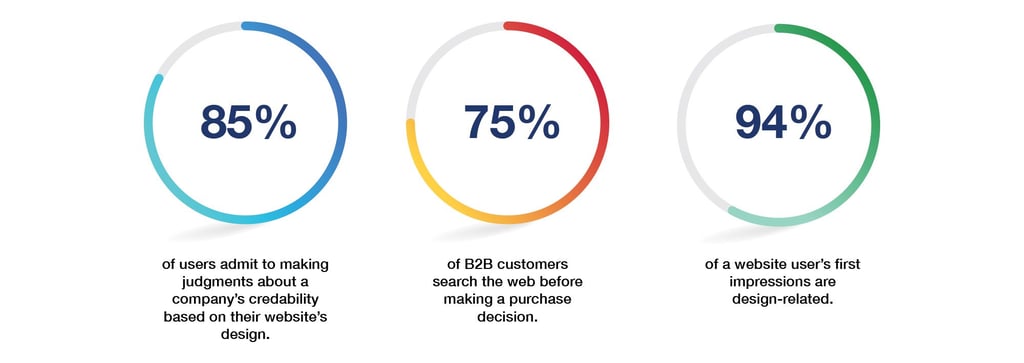Considering that there are 4.66 billion active internet users worldwide, every business should be working to transform its website into its greatest sales tool.
First impressions count. In fact - every impression counts. This is why growth-driven design is proving to be the most practical way to create a website that works as hard as you do.
If you're considering a redesign or even simply a refresh, these ten interesting facts about website design will help you understand what really matters, how to avoid costly design mistakes, and how to attract, engage, and convert even more of those 4.66 billion active internet users.
Facts About Good Websites
1. Web Design Influences Perceptions of 3 in 4 Users
Appearance and credibility are inextricably linked. According to web credibility research from Stanford University, 75% of web users admit to making judgements about a company’s credibility based on its website design.
2. You Have Less Than 1 Second To Impress
Ok, so your company’s credibility is based upon your website design, so how long have you got to make that important first impression?
The bad news is studies have shown that it takes only 50 milliseconds (that’s 0.05 seconds!) for users to form an opinion about your website. Quite literally, a decision is formed in the blink of an eye.
3. Web Design = User Experience
First impressions stick. A positive first impression about your website has been found to lead to ongoing higher user satisfaction and can have a priming effect on your customer's future interactions with your business.
Research shows that positive priming can boost user satisfaction and conversely, unfavourable first impressions have a significant ongoing negative effect on future user satisfaction.
4. Small Mistakes Have Big Impacts
You should avoid website errors of all types, no matter how small they seem. Stanford University researchers found that broken links and typographical errors have a significantly more negative effect on users' opinions of websites and businesses than people may first assume.
Get proofing that website!
5. Mobile-First Is Key
Over 92% of all internet searches are now completed on mobile. Yes, you read that correctly. Of the 4.66 billion active users we introduced at the start of this article, less than 8% of them use desktop or tablet to browse the www.
So what does this mean for your website? It means that an increasing number of your users will view your website on a small screen, so your website needs to be not only responsive (changes size for different devices) but also will likely need to include elements that are specifically designed for mobile.
6. Nearly 8 in 10 Will Bounce If Your Site Disappoints
And they'll be driven straight into the arms of your competitors... Impact says that 79% of people who don’t like what they find on one site will go back and search for another site.
If you've done the hard work of ranking for the keywords and convincing the user to click through to your site, don't let poor design drive them away to the next best thing.
7. It's What's Under The Bonnet That Counts
Your website is like a sports car. It may look great, but the real performance comes from what is under the bonnet. Behind your website, the underlying source code can affect your search results.
You will need a professional web developer to implement SEO & coding best practices in order to improve your rankings for search engine optimisation (SEO).
8. Relevance Impacts Rankings AND Credibility
This surely shouldn't come as a surprise. Stanford research shows that internet users assigned higher credibility to websites that had been updated regularly and often.
Businesses often make the mistake of investing every few years in a website refresh and then neglecting the site once it's been updated. We do agree that there's a time and place for empirical content, but that time is not now, and the place is not here.
Growth-Driven Design focuses on identifying questions and topics your audience is discussing and helping you connect with them by providing the content they actually want.
9. Time Really Is Money
In today’s world, people do not hang around. The average mobile page takes 9.3 seconds to load, and the average attention span of humans is 8 seconds.
When the odds are already stacked against you, don't let slow page loading speeds drag you down even further.
Your website load speed can be affected by pictures, videos and coding practices.
10. 5 in 10 Google Searches Result In Zero Clicks
Half of all searches won't progress past the search engine results page (SERPs). Perhaps this is because many search queries are answered aptly through Rich Results and Featured Snippets.
It's hard to say for sure, but one thing we can say with certainty is that if you manage to get a user to click through to your site, you'd best be sure you're getting them to convert.
Conversion Rate Optimisation will help you identify user behaviour, and adapt your website to make more from your web traffic.
Website Design Has Never Been So Important
The stakes have never been higher for professional businesses when it comes to web design. When competition is this fierce, you need to ensure your website is working with you and not against you.
At Digital Media Stream, we've helped many businesses implement and execute successful growth-driven design websites. As our ten facts have illustrated, the tech world is constantly evolving and online credibility is something that is hard-won, and easily lost. Make sure your website is as professional as the rest of your business.
To find out how growth-driven design can support your business goals in the overcrowded marketplace that we all find ourselves in, you can book a FREE consultation with one of our experts.



